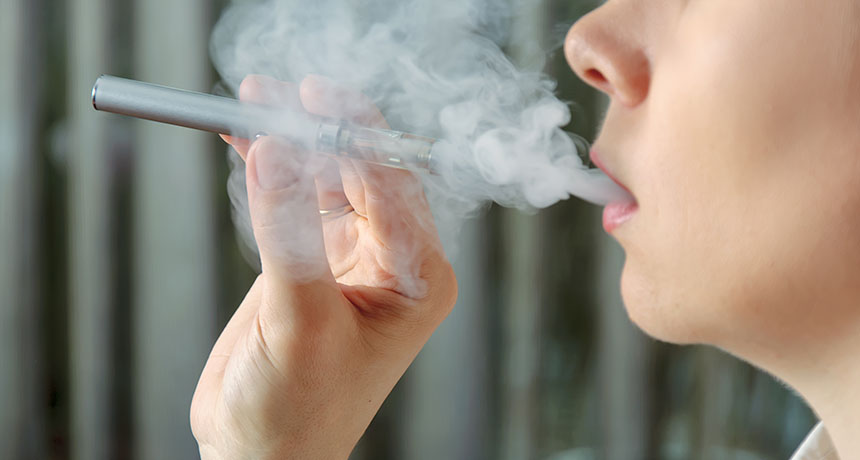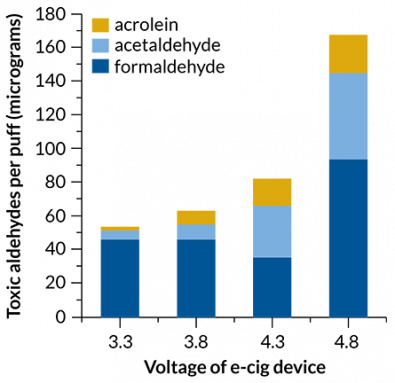E-cigs create toxic vapors from harmless e-liquids
And with increasing use, electronic cigarettes become richer sources of these toxic chemicals

Girl vaping on an e-cigarette. The cloud of gases these devices emit can contain toxic chemicals. Which chemicals and how much depends on how the device is used and the solvent used in the e-liquids, new data show.
AlexShalamov/iStockphoto
By Janet Raloff
Some people think electronic cigarettes, which don’t contain tobacco, are a safer alternative to true cigarettes. But smoking e-cigarettes, or vaping, exposes people to toxic gases that can harm the lungs and cause other health problems. Now, a new study shows that the hotter an e-cig gets — and the more it’s used — the more toxic compounds it gives off.
Hugo Destaillats is a chemist at Lawrence Berkeley National Laboratory in California. His team has just turned up a host of toxic chemicals in the vapors generated by electronic cigarettes. Some have never before been seen in vaping emissions. “There is this image that e-cigarettes are a lot better than regular cigarettes, if not harmless,” Destaillats says. As a result of the new research, he says, “We are now definitely convinced that they are far from harmless.”
Key to vaping is the e-liquid that is drawn through an e-cigarette. Manufacturers dissolve flavorings, and usually nicotine, into this solvent. In most cases, this solvent is known as food-grade, meaning it should be safe enough to eat. (But that rating is meaningless if the solvent will be inhaled into the lungs, not ingested into the stomach, where it can break down.)
As a vaper inhales, some of the flavored solvent will flow through the e-cigarette. As it passes over one or more hot metal coils, that liquid vaporizes into a gas.
These flavored vapors can be a rich source of toxic chemicals. One of those toxic chemicals is nicotine. It is usually added to the starting liquid to stimulate a user’s nervous system the same way that tobacco cigarettes will. (Indeed, e-cigs are considered “tobacco products” by government agencies because their nicotine comes from tobacco plants. ) But the new study finds that the solvents make even more chemicals that are bad to breathe in. As the solvents encounter an e-cig’s intensely hot coil, they can break down to form new toxic compounds.
Those chemicals include formaldehyde (For-MAL-duh-hyde) and acetaldehyde (AA-sit-AL-duh-hyde). Both are considered likely to cause cancer. Another toxic aldehyde — acrolein (Aa-KRO-LEE-un) — can severely irritate the eyes and airways.
The Berkeley team used two current types of e-cigs and three different e-liquids. Their test equipment mechanically drew air through the electronic devices. This created vapors that a user would normally inhale. The chemicals making up those vapors changed as the e-cigs heated up. That means the first puffs contained somewhat less of the toxic chemicals than later puffs did.
Some e-cigs, such as ones they used in these tests, allow a user to vary the voltage (battery power used to heat the metal coils). Higher voltages produced hotter coils and more of the toxic chemicals.
The team presented its data July 27 in Environmental Science & Technology.
The role of heat and dirty ‘gunk’
The bottles of e-liquids used in the new tests came from the store with tiny traces of aldehydes, Destaillats notes. But the levels were too low to matter. However, he reports, “through the process of vaping, you are generating almost 1,000-fold higher emissions of those same compounds.”

What seems to be happening, he says, is that the more heat you pour into the e-cigarette, the faster it makes the liquid evaporate. At some point, however, the liquid can’t get any hotter. So putting even more heat into it no longer just vaporizes it. Now the liquid actually breaks down into new, and more toxic, chemicals.
That increase in the formation of toxic gases tended to climb gradually as the coils got hotter. But at high voltages that changed. Suddenly, Destaillats notes, there was a sharp boost in the three most harmful aldehydes present in the vapor.
In most of their tests, the chemists used a new e-cigarette for each puffing session. But for one set of tests, they used the same device over and over. They also set it at a high-voltage level. After the ninth 50-puff cycle, they compared the vapors coming out to those from the first few puffs. And the vapors were different. The later ones contained 60 percent more aldehydes than the first few puffs had.
This effect matched what would be expected if there was a chemical buildup on or near the heating element, the scientists say. As e-liquids break down, they will leave some residues behind. The slang term for this stuff is “coil gunk.” These residues, the Berkeley scientists now say, would serve as an additional source of material from which to make toxic aldehydes.
What’s new here
Realizing there are changes in the vapors of well-used e-cigarettes “is something new,” notes Maciej Goniewicz. He’s a toxicologist at the Roswell Park Cancer Institute in Buffalo, N.Y. He also has studied the role of e-cigarette types and power levels on aldehyde production.
The Berkeley team used a better analytical technique than others have employed, including his group, Goniewicz says. And with this new technique, the Berkeley team turned up new compounds in the vapors, he points out. These include propylene oxide and glycidol. Both are toxic, he notes. Neither his group nor others had previously been able to see these in e-cig vapors.
Studies such as the new one are important, he says, “because they will help us understand exactly what people are inhaling.”
Such data also can point out ways to vape more safely, argues Destaillats. “In a way,” he says, “the message to people using e-cigarettes is: If you’re going to vape, try using the lowest voltage possible, for the lowest temperature.”
But in no circumstances should teens be vaping, he notes. Yet data show that plenty do. And access to these potentially dangerous products has been fairly simple. Although most U.S. states have made it illegal for teens to buy vaping goods, these supplies could still be ordered over the internet.
That could change soon. In May, the U.S. Food and Drug Administration said vaping products would be treated no differently than cigarettes and other tobacco products in terms of young people. It will violate federal law to sell or give vaping products to U.S. minors.







